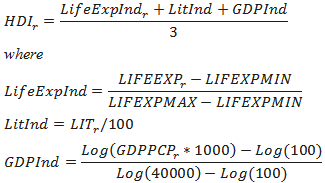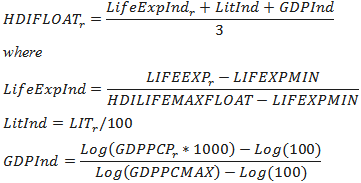International Futures Help System
Human Development
Human development measures invariable look to such variables as life expectancy, literacy or other indication of educational attainment, income, etc. These variables are computed in other IFs models, but provide a basis for socio-political analysis.
Literacy is a variable fundamentally tied to educational attainment. In IFs it changes from the initial level for a country because of a multiplier (LITM).
![]()
The function upon which the literacy multiplier is based represents the cross-sectional relationship globally between the percentage of adults who have completed a primary education (EDPRIPER from the education model) and literacy rate (LIT). Rather than imposing the typical literacy rate from this function (and thereby being inconsistent with initial empirical values), the literacy multiplier is the ratio of typical literacy given future adult primary completion percentage to the normal literacy level at initial primary completion percentage.
![]()
At one time the IFs system represented an aggregate view of life conditions within a society by using the Physical Quality of Life Index (PQLI) of the Overseas Development Council (ODC, 1977: 147#154). This measure averaged literacy, life expectancy, and infant mortality, first normalizing each indicator so that it ranges from zero to 100.
The United Nations Development Program's human development index (HDI) has fully supplanted that early measure in the development literature. The HDI began as is a simple average of three sub-indices for life expectancy, education, and GDP per capita (using purchasing power parity).. The GDP per capita index is a logged form that runs from a minimum of 100 to a maximum of $40,000 per capita. The original measure in IFs differs slightly from the original HDI version, because it does not put educational enrollment rates into a broader educational index with literacy.

Although the HDI is a wonderful measure for looking at past and current life conditions, it has some limitations when looking at the longer-term future. Specifically, the fixed upper limits for life expectancy and GDP per capita are likely to be exceeded by many countries before the end of the 21st century. IFs therefore introduced a floating version of the HDI, in which the maximums for those two index components are calculated from the maximum performance of any state in the system in each forecast year.

The floating measure, in turn, has some limitations because it introduces relative attainment into the equation rather than absolute attainment. IFs therefore developed still a third version of the original HDI, one that allows the users to specify probable upper limits for life expectancy and GDPPC in the twenty-first century. Those enter into a fixed calculation of which the normal HDI could be considered a special case.

In 2010 the Human Development Report Office of the UNDP changed its computation of HDI and the IFs model followed suit with a new version named HDINEW. That measure moved to a different aggregation of the components, one that uses a geometric mean of the component elements. It further changed the computation by creating a revised education index that is a geometric mean of two subcomponents, mean years of schooling of adults (EDYRSAG25) and expected years of schooling of school entrants (EDYRSSLE). It continues to use life expectancy (LIFEXP) and gross national income per capita at PPP, for which IFs substitutes GDP per capita at PPP (GDPPCP).

We further compute several global indicators including a world life expectancy (WLIFE) and a world literacy rate (WLIT).

 International Futures at the Pardee Center
International Futures at the Pardee Center